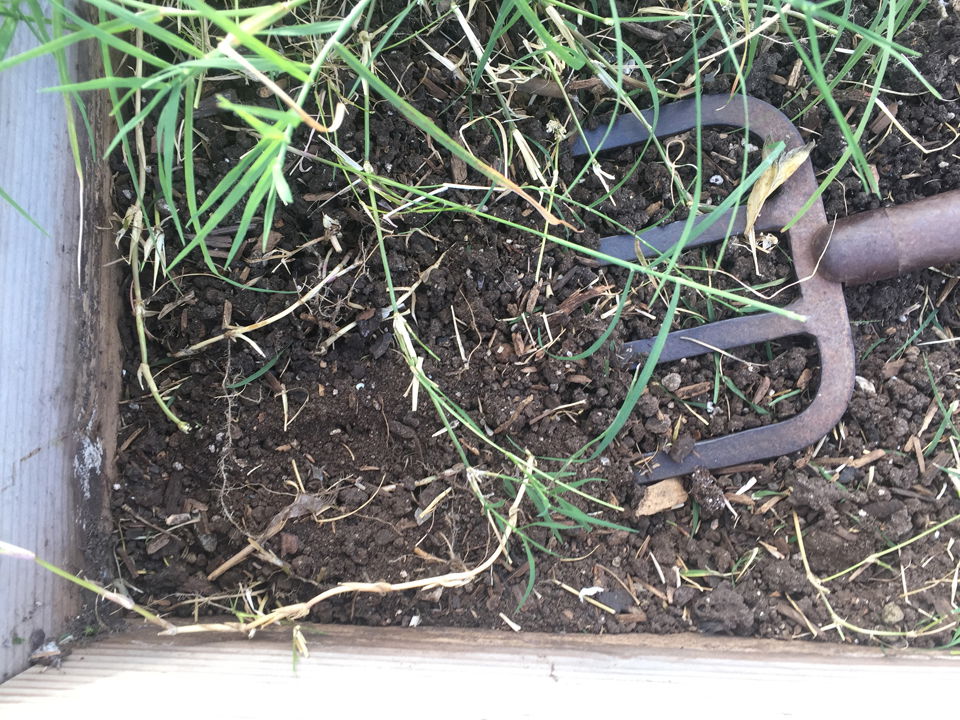The Bermuda Grass Project
The sheer tenacity of Bermuda grass makes it a great choice for lawns and golf courses, but it can be one of the most frustrating weeds for a gardener to deal with. Underground roots, or stolons, spread the weed aggressively, and pieces left behind after weeding sprout anew. As if that weren’t bad enough, it also spreads by airborne spores.
This grass is so pervasive in our area that it shows up everywhere we irrigate. It is a fact of life in Southern California.
So, what’s a gardener to do? Excavate the soil and haul it away, only to have the grass reappear? Lay down barrier cloth, which the roots grow right through? Give up, buy a mower and make a putting green? Use Round-Up?
The good news is that none of these heroic (or poisonous) methods are necessary, nor are they a permanent solution. The only thing that truly works is attacking the weed repeatedly and often.
Just as you can’t clean your kitchen floor so completely that you’ll never have to wash it again, you can’t weed so thoroughly that you will never have Bermuda grass again. It can’t be gotten rid of all at once, However, you can keep your garden weed-free with a regular weeding session—the key is repetition. Working 10 minutes a week, and doing it every week, is easy and more effective in the long run.
“But,” you say, “I already weed every week and it keeps coming back!” It’s likely you weed one area one week, then another the next week, another the next week and so on. By the time you get back to the first spot it is solid grass again. This is so frustrating and discouraging that many gardeners give up.
Instead, follow this method: once you have cleared a small area, keep that area cleared before moving on to other weeds. Each week, weed your cleared area first before expanding. It is the second, third and fourth passes that finally get the grass under control. This really works, and it also works for other perennial weeds such as nutgrass and bindweed.
If you don’t believe me, Isee what happens in this 10’ x 10’ garden plot whose weeds got the better of it in late summer.
Sept. 25

“Help me!” cried the gnome. The infestation seems impossible, but you only need to commit to a weekly session of 10 minutes. Anyone can do that! Let’s get started.

Set your timer for 10 minutes. Use a digging tool to loosen the underground roots, and pull out as much material as possible. After 10 minutes, you have cleared an area of a few square feet.

Oct. 1: One week later, your cleared spot has some new sprouts!

Of course it has; the stolons left behind are going to send up shoots. Now is the time to remove them, before they have a chance to re-establish their network. You removed about 80 percent of the root system on your first attack—now you will be removing 80% of what is left.
Let’s give it another 10 minutes. You could spend longer if you’d like, but the idea here is to weed weekly for a reasonable amount of time, not to wear yourself out trying to get all the weeds in one go. Your cleared area has doubled in size.

Next week you will spend a couple minutes re-weeding it before moving on. As long as you are committed to coming back next week, soaking the ground is a good way to encourage the remaining bits of Bermuda grass to sprout, revealing themselves for removal.
Oct. 9: Those pesky roots are still sprouting.

Don’t be discouraged. Just keep digging them out each week. The stolons like to crawl along boards and tree roots. These spots take extra attention.
Oct. 17: This time, there is not as much regrowth.
After 10 minutes of weeding, it seems safe to plant a few things in that first corner, which has been weeded four times now.

Oct. 24: Expand your cleared area each week.

Oct. 30:

Nov. 7: Keep removing the new sprouts in your cleared area before making it larger.

Nov. 13:

Nov. 19:
Nov. 26: It’s been two months, and the garden has really turned a corner! We’ve already harvested arugula and radishes, and the growing space keeps growing.

Keep up the weekly weeding, starting by keeping your cleared area cleared, and plant those areas that are under control.
- Joe Corso